Advances in
eISSN: 2373-6402


Review Article Volume 2 Issue 2
Department of Plant Science, Wollo University, Ethiopia
Correspondence: Oadi N Matny, Department of Plant Protection, College of Agriculture, University of Baghdad, Iraq, Tel 7903265841
Received: January 27, 2015 | Published: March 5, 2015
Citation: Matny ON. Lentil ( Lens Culinaris Medikus ) current status and future prospect of production in Ethiopia. Adv Plants Agric Res. 2015;2(2):45-53. DOI: 10.15406/apar.2015.02.00040
Lentil is among the oldest domesticated crop in the world. It is a cool season food legume playing a significant role in human and animal nutrition as well as soil fertility maintenance. It can be grown in rotation to cereal crops which promote sustainable cereal-based production systems with a potential of fixing free nitrogen reached up to 107kg ha-1. It is the most important crop because of its high protein content and fast cooking characteristic. The major lentil-growing countries are Canada, India, Turkey, Australia, USA, Nepal, China, and Ethiopia. Lentils have an indeterminate growth habit and flowering begins from the lowest branches, gradually moving up the plant and continuing until harvest. It is well adapted to various soil types and also considered as drought-resistant crop. But it is susceptible to excessive water stress. World lentil production has been increasing in recent years with most of the production coming from North American and Asian countries. Productivity of lentil in Ethiopia varies from region to region due to variation in environment and biotic factors. Currently, lentil is considered as a cash crop that fetches higher price compared to most of the cereals and pulses grown in Ethiopia. It is often claimed that, the internal (local) market seriously competes with the external market. Lentil has huge potential of reducing poverty and contributes to sustainable economic development in Ethiopia. Despite the country’s potential and sustained development efforts to get the pulse sub-sector moving, the competitiveness of lentil and hence its contribution to economic development is threatened by low productivity and inconsistent supply of products that does not met both export quality and quantity. On the other hand, the ever increasing population and ever changing client demand of lentil is the good opportunity for boosting production at farm level. In Ethiopia, lentil has received little attention in research, development and external fund attraction. Thus, it is essential to work with federal and regional seed enterprises, farmers’ cooperatives, unions, and seed producing farmers with involvement of private sectors in a coordinated manner to ensure adequate supply of locally certified seeds. It is also necessary to develop recommendations for organic and inorganic fertilizers that are most suitable for lentil production. These recommendations will depend on soil maps and controlled trials of blended fertilizers to determine the optimal balance of macro- and micro-nutrients. Providing of effective extension service is inevitable to break the existing resistance by awareness creation through demonstration at farmers training centers. Complementary lentil technologies including tillage frequency, seed treatment, planting techniques, genetically improve seed, pests and weed management practices have to be provide to boost production. Indeterminate growth habits of lentil makes not to mature at the same time and brought sever shattering problems before harvest. Harvesting while it is still green is recommended as one option to reduce shattering. Research on the development and promotion of tools (harvester) that would enable farmers to harvest lentil on time is important. Increasing farmers’ access to price information, increase the transparency of the market and would enable farmers make better selling decisions and provide increased bargaining power. The establishment of strong linkage among producers, suppliers, consumers, processors, whole sellers, and retailers is inevitable to begin value chain. A review has been made for boosting production and creating the demand for the use of improved technology keeping in view the enormous contribution of lentil for food and nutritional security.
Keywords: lentil, production, potential use, agro-technology, constraints and future strategies
Lentil (Lens culinaris Medik) is one of the most ancient annual food crops that have been grown as an important food source for over 8,000years.1,2 It is one of the early domesticated species, as old as those of einkorn, emmer, barley and pea for cultivation.3,4 Canada, India, Turkey, Australia, United States of America, Nepal, China, and Ethiopia are the major players in global lentil production.5 Both red and green lentils are produced in the region with variable proportion. It is an important crop in food, feed and farming systems of West Asia and North and East Africa.6 It has been established in a wide range of agro-ecology but production is limited to tropical areas. The spread of lentil from the center of origin has been accompanied by the selection of traits important for adaptation to environments that can be climate, soil and their impact on season length, abiotic and biotic stresses.7
Lentil plays a significant role in human and animal nutrition and in maintenance and improvement of soil fertility.8,9 Its cultivation enriches soil nutrient status by adding nitrogen, carbon and organic matter which promotes sustainable cereal-based systems of crop production.8 It is a nutritious food legume. It is cultivated for its seed and mostly eaten as split.10 The primary product of lentil is its seed which has relatively higher contents of protein, carbohydrate and calories compared to other legumes.11 It is the most desired crop because of its high average protein content and fast cooking characteristic in many lentil producing regions. It can be used as a main dish, side dish, or in salads. Seeds can be fried and seasoned for consumption but sometimes difficult to cook because of the hard seed coat those results from excessive drying.12 Its flour is used to make soups, stews, purees, and mixed with cereals to make bread and cakes; and as a food for infants.13
Origin, distribution and taxonomy of lentil
Cultivated lentil is thought to have been originated and first domesticated in western Asia and then introduced into the Indo-Gengetic plain around 2000 BC.14 Lentil has also been rapidly spread to Egypt, central and southern Europe, the Mediterranean basin, Ethiopia, Afghanistan, India, Pakistan, China and later to the new world including Latin America, Mexico chili, Argentina, Colombia and more recently Canada.4 According to Cubero,15 lentil was first spread to the Nile from the near east, to Central Europe and then to the Indian Subcontinent and the Mediterranean Basin by the end of Bronze Age. It is now cultivated in most subtropical and also in Northern hemisphere such as Canada and Pacific Northwest regions.2
Lentil belongs to the genus Lens of the Viceae tribe in the Legumnosae (Fabaceae) family, commonly known as the legume family.16 The plant was given the scientific name Lens culinaris in 1787 by Medikus, a German botanist and physician.17 The cultivated lentil, Lens culinarisspp. culinaris, has two varietal types: small seeded (microsperma) and large seeded (macrosperma).18 It is an annual bushy herb with slender stem and having many branches with erect, semi-erect or spreading growth habit.19
Lentil plants are typically short, but can range from 20 to 75cm in height, depending on growing conditions.20 The cotyledons remain under ground after germination. The first two nodes on the stem develop below, or at the soil surface and are known as scale nodes. Plants can have single stems or many branches depending upon the population in the field. Lentil plants have an indeterminate growth habit. Flowering begins on the lowest branches, gradually moving up the plant and continuing until harvest.2,21 Lentil continue to flower until they encounter some form of stress, such as drought, heat, frost, nitrogen deficiency, mechanical damage, or chemical desiccation. This indeterminate growth habit is most predominant in late maturing varieties, but all current lentil varieties have indeterminate growth habit. Flowers of lentil are self-pollinated22 and first few flowers on the main stem may abort. This occurs if conditions favour excessive vegetative growth over seed production, such as good moisture combined with high nitrogen fertility.23
Present status of lentil production and consumption
Lentil is currently an important pulse crop grown widely throughout the Indian Subcontinent, Middle East, Northern Africa and East Africa, Southern Europe, North and South America, Australia and West Asia.24,25 It is a primary component for farming systems of those areas.8 The major lentil-growing countries of the world are Canada, India, Turkey, Australia, USA, Nepal, China, and Ethiopia. Out of the total increased volume of global production in recent years, the most is coming mainly from Canada and India (Figure 1).
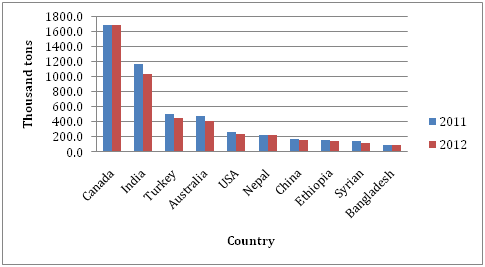
Figure 1 Global Major Lentil producing nations (in 1000’tons) in 2011 and 2012.
Source: FAOSTAT (http://faostat3.fao.org ) accessed 23 November, 2014 [26].
The total lentil cultivated area in the world is estimated around 4.34million hectares with annual production and productivity of 4.95million tons and 1260Kgha-1 respectively.26 The production of the crop is increased significantly from year to year through expansion of net cropped area along with its productivity (Figure 2). This increment was stimulated by greater improvement in demand of both domestic and international market of the crop. Even though lentil producing nations are striding in skyrocketing of their production to fill domestic demand and overwhelming of the export market but still the supply gap remains wide which is aggravated by rapid population growth, ever changing client demand and limitation in genetic improvement of the crop. Most of the production which reaches around 56% is consumed locally and only 44% of the production is supply to the global market.27 Canada is the Leading exporting nation, while India is the leading lentil consuming and producing nation.28

Figure 2 Area harvest and production trend of lentil in the world.
Source: FAOSTAT (http://faostat3.fao.org ) accessed 6 January, 2015.The enrichment of lentil with high protein makes it the prefer pulse crop to rural poor household in the world who are not afford expensive animal products. Because of this nature, lentil is called poor man’s meat due to its low price compared to meat. It efficiently complements the cereal rich food in making nourishing meal by balancing the amino acid and micronutrient content of the diet. Enhancement of productivity of lentil is very vital as most of the poor people in the world are depend on it for protein supply to meet their food, nutritional, and healthy benefits. Lentil cultivation is expected to increase rapidly in the future due to its demand for consumption and agronomic ability to assimilate atmospheric nitrogen.
Lentil is amongst the principal cool season food legumes.29 It is grown as a winter crop in Ethiopia and particularly important in Oromiya, Amhara and some parts of South Nations Nationalities and Peoples and Tigray regions.30 It is one of the less selective legumes in terms of climate and soil features.4,31 It usually well adapted to various soil types ranging from sand to clay loam when there is good internal drainage.32,29 It appears very sensitive to Water logged field conditions and even with short period of exposure it can cause the crop to die easily.33 It performs best on deep, sandy loam soils with high in phosphorus and potassium content. It is widely grown in areas having an altitude range of 1,700-2,400meters above sea level with annual rainfall ranging from 700-2,000mm in Ethiopia.30,34 High humidity with excessive rainfall during growing season promotes vegetative growth, which prevents latter good yield and seed quality.
Lentil is considered as drought-resistant crop that can tolerate low annual rainfall distribution even in the range of 280-300mm.33 In regard to temperature, lentil can grow in different environments from cool temperate steppe to subtropical dry zones.35 Different types of lentils are now grown in large areas of warm temperate, subtropical and high altitude of the tropics as a cool season crop.12 Lentil is capable of germinating at a temperature above freezing point but optimum germination occurs at the range of 18-21°C. Temperatures exceeding 27°C can harm the crop aggressively but optimum temperatures for growth and yields of lentil are around 24°C.36 A soil pH of 6-8 is conducive for lentil production, but it can also tolerate a moderate alkalinity.37
Lentil is mainly grown in the highlands of Ethiopia where rainfall is usually high.38 It is highly susceptible to excessive moisture stress hence farmers grow lentil on sloppy fields or use ridge and furrow system to drain excess water from lentil field specifically from black soils (Vertisols).37 Ethiopian farmers plow lentil fields three to four times using traditional “Maresha”30 and the first plowing is done from March to May30 which is a period of short rainy season. The second and third plowing operations are undertaken in mid-June and early August, respectively.30,34 Double yield advantage of lentil can be obtained by ploughed two to three times accompanied with twice hand weeding.38 Lentil planting date varies from place to place depending on the amount and distribution of rainfall, temperature, topography and elevation of the area.39 Previous research findings, recommended lentil planting time in Ethiopia should be late June to mid-July in both mid and high altitude areas.40
Legumes have always been critical components of the agro-ecosystems throughout the world because of their ability to fix atmospheric nitrogen into usable plant proteins. Their ability to grow in Nitrogen poor soils and their contribution to the pool of soil nitrogen that can be used by succeeding crops.41 Around 250million hectares of legumes are grown in the world and fix about 90 trillion gram of nitrogen each year.42 Nitrogen fixing legumes save approximately US $7-10billion of nitrogen fertilizer each year.43 The fixed nitrogen is used directly for plant growth and provides an excellent source of protein for humans and livestock.
The level of Nitrogen fixation by legumes varies considerably both spatially and temporally in response to host of environmental and ecological factors.44,45 According to Carranca et al.,46 nature of distribution of rainfall at vegetative growth stage affects the N2 fixation capacity of lentil. Matus et al.,47 reported that N2 fixation of lentil was 10% higher when grown in zero tillage as compared to conventional tillage practices. The study by Saxena et al.,48 indicated that lentil can have a capacity to fix up to 107kg N/ha. This implies about 13,238 ton of N can be fixed annually in Ethiopia. Moreover, it offers an indispensable additional advantage emanating from its unique property in restoring and maintaining soil fertility.37,49 Lentil can be used as a green manure crop and particular Canadian variety, Indianhead, provides a large amount of fixed nitrogen which is estimated about 22.4kg ha-1).2
Nitrogen fixation of lentil is highly influenced by the type of cropping system followed and it is greater in highly diversified crop rotation than in less diversified crop rotations.47 Nitrogen fixation capacity of Lentil is significantly higher when grown in intercropping with other legume species than mono cropping. The crop is generally grown in rotation with cereals to break cereal disease cycles and to maintain soil nitrogen, thus reducing the demand of other cereal crops for nitrogen fertilizers.16,38 Prakash et al.,50 reported that there was 23.4% increase of soil nitrogen in rice yields following lentil production compared to wheat in India.
Fertilizers affect the root development and biomass production of plants. This could have an effect on nitrogen fixation of legumes. Hence quantification of the effect of fertilizers on nitrogen fixation of legumes is essential and is given an attention.51 A study on the need for Rhizobium inoculation in lentil was carried in 1989 at two locations of Ethiopia (Ginchi and Dembi). The results showed no significant yield differences among the treatments due to the effect of nitrogen fertilizer application. There was no good nodulation at either of the location, which may be due to local soil factor.52 Similarly, results of an international inoculation response trial on lentil indicated that there were no significant differences among the treatments.53
Small scale farmers in Ethiopia grow various crops for own consumption and economic benefits. Pulses are among the crops produced in all the regions of the country following cereals in terms of total production and area coverage.54 Lentil is one of the major highland pulses of Ethiopia that grows in rotation with tef, wheat and barley particularly on the heavy black soils (vertisols).38 It is an important part of the farming system and essential to nutrition in the subsistence farming community in Ethiopia.30 In such culture, a yield advantage of the succeeding cereal crop is realized as a result of the fixed nitrogen by the predecessor legume and also due to breakage of the life cycle of important diseases and insect pests.28
It is one of the heavily consumed pulse crops in Ethiopia and is a popular ingredient of every day diet in the majority of households.37 It is an invaluable source of protein (23-24%) for the vast majority of Ethiopian masses. It is consumed in different forms of preparation(split or whole grain stew form Asambusa and sometimes as roasted or boiled whole grain snack alone or often mixed with cereals or other pulses).9,55 So that it’s local consumption is extremely high in Ethiopia.40 The relatively high level of lysine in lentil compensates for low concentration in cereal grains hence when consumed in combination gives nutritionally well balanced diet.56 The straw/haul is an important source of feed for animals fattening.33
Lentil production is mainly depends on soil type, altitude and agro-ecologic conditions. In Ethiopia, Its production is not mechanized and produced by small holder farmers with fragmented plots of land mainly for household consumption.38 The average annual total harvests of lentil for the last ten years in Ethiopia were about 90,159.63 tons of grains from about 92,998.61 hectares of land.57 Annual agricultural sample survey by CSA indicated that the countries pulse production (particularly lentil) shows an increasing pattern since 2003/2004 till now (Figure 3). The total annual area covered by pulses for the last 10years increased on average by 6% and that of lentil increased by 11.1%. Annual average production growth rate of pulses for the last 10years was 11% and that of lentil was 19.03% (Figure 3). The total lentil production harvested during 2012/2013 growing season was 151,499.93 tones which were out yielded by 18.35% to128, 008.8 tons obtained in 2011/2012 cropping season.
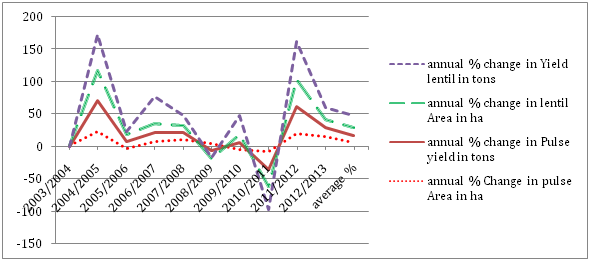
Figure 3 Trends in % changes of annual area coverage, yield of pulse and lentil in Ethiopia.
Source: Author’s calculation based on various annual agricultural sample surveys (CSA, 2004-2013) publications.57
Ethiopia is the leading producer of lentil in African followed by Morocco, Tunisia and seventh in the world (Figure 1). Ethiopia covers 69.4% of the areas devoted to lentil and 81.5% of the total production in Africa.26,54 Average lentil productivity is about 1230Kg ha-1,54 1150Kg ha-1 and1260 Kgha-1,56 for Ethiopia, Africa and the World, respectively.
Ethiopian farmers have managed to double their production of lentil in the past decade but still the current national average productivity is found to be 1.23tha-1 (Figure 4). However, improved varieties can yield 1.4-5tha-1 under research fields and 0.9-3tha-1 under farmers’ fields with full use of agronomic packages. The huge gap of productivity difference between farmer’s field and on station is due to variability of crop husbandry practices such as soil, crop, fertilizer and water management. Currently, the productivity of the crop has change significantly due to the release of few improved varieties and with modernization of crop husbandry practices in the farming community but still lentil is low in productivity compared to other legumes growing in the nation (Figure 5).
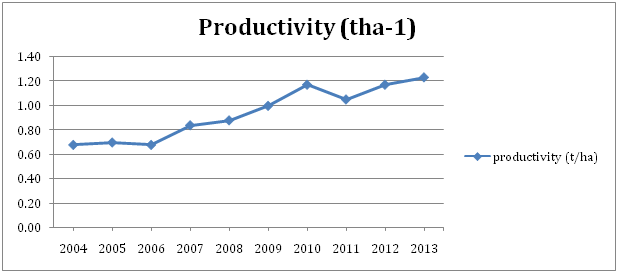
Figure 4 Trends in productivity of lentil in Ethiopia
Source: Author’s calculation based on various annual agricultural sample surveys (CSA, 2004-2013) publications.57
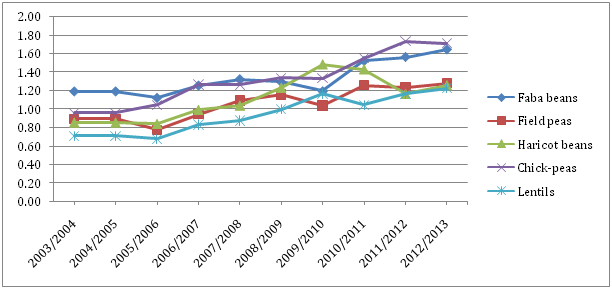
Figure 5 Trends of pulse productivity in Ethiopia (tha-1).
Source: Author’s calculation based on various annual agricultural sample surveys (CSA, 2004-2013) publication.57
Lentil research was formally started in 1972 and DebreZeit Agricultural Research Center was assigned to coordinate the national lentil research program. The center has released Teshale (FLIP 96-46L), AlemTena (FLIP 96-49L), Assano (Flip 88-46), Alemaya98 (Flip 89-63L), Gudo (Flip 84-78L), ADA (Flip-86-14L), Chalew (NEL 358), Checole (ENAL-2704), El-142 and R186.58 Among these El-142, AlemTena (FLIP 96-49L) and Alemaya 98 (Flip 89-63L) were released for the low land dry areas. Variety R186, Chalew (NEL 358), Gudo (Flip 84-78L), ADA (Flip- 86-14L) and Alemaya 98 (Flip 89-63L) were for the central, northern and south eastern highlands of Ethiopia.59 All these varieties are rust resistant but Adaa is resistant to both rust and fusarium wilts. Variety R186, which was performing well in the highlands where crops growth period was long was hit by frost in two seasons. Hence it was removed from the production and followed by Chalew.
However, it was difficult for the researchers to deliver these varieties into the hands of farmers since Ethiopian farmers keep their own seeds from the previous season’s crop. Based on the assessment carried out by Setotaw60 in central high land of Ethiopia, adoption of improved lentil varieties was found to be below expectations. Only 9% of lentil growers adopt improved varieties. In terms of intensity of adoption, nearly 9% of the total lentil areas are covered with improved varieties. In general, the limited adoption of improved lentil varieties is attributed to the current incidence of disease and insect problems. Especially, disease is main threat of lentil production which sometimes causes a complete crop failure. The other major factor hampering the wider dissemination of the available lentil varieties is the current seed production problem.
Lentil is dominantly produced by smallholder farmers based on their indigenous knowledge.40 It is produced without chemical inputs and said to be organic even though it is not certified. Ethiopia was among the five top lentil producing countries of the world in the early 1970s.61 However, its production was reduced to about 26,000tons in the mid/ late-1980s. This was happened due to controlled market and fixed price by the so-called communist military regime.62 However, this decline was arrested and reversed in the early 1990s due to liberalization of market and the production reaches about 151,499.9tonsfor the last 14years.54 This was accompanied by partial improvement of extension services, market liberation, and release of new varieties through research and access to other basic inputs.
Annual lentil production has grown from 35,274.8 to 151,499.93 tons between 2003/04 and 2012/2013 cropping season (Figure 6). The increase in production, however, has not created a substantial surplus for export as most of the product is consumed locally. The demand for this commodity both in local and international markets has increased significantly in recent years.63 Its local market price is also higher than most pulse crops (Figure 7). It is often claimed that the internal (local) market seriously competes with the external market.34,37 Currently, lentil is considered as a cash crop that fetches higher price compared to most of the cereals and pulses grown in Ethiopia (Figure 7).
Ethiopia has improved its lentil export since 2005. However the strong demand and high price in the local market heavily competes with the international market, so that its export share is low as compared to other pulse crops (Figure 7) (Figure 8). The country has exported 5,133 and 17,640 tons in 2005 and 2010 respectively (Figure 9), as compared to 885-1,728 tons in between 2001-2002.40
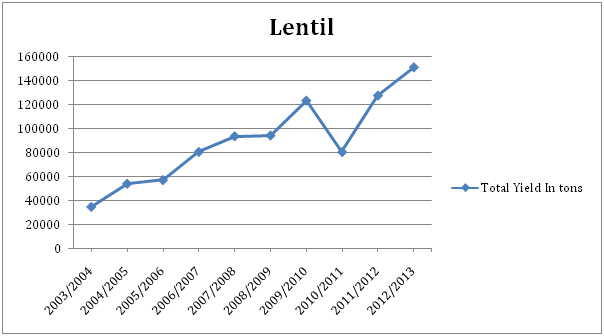
Figure 6 Lentil production trend in Ethiopian.
Source: Author’s calculation based on various annual agricultural sample surveys (CSA, 2004-2013) publications.57

Figure 7 Ethiopian pulse producer’s price (US $/ton) (USD).
Source: FAOSTAT (http://faostat3.fao.org ) accessed 23 November, 2014.26
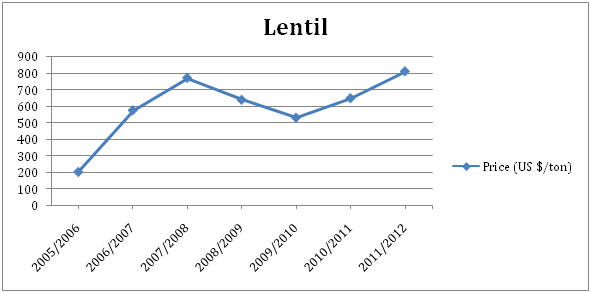
Figure 8 Ethiopian Producers price (US $/ton).
Source: FAOSTAT (http://faostat3.fao.org) accessed 23 November, 2014.26
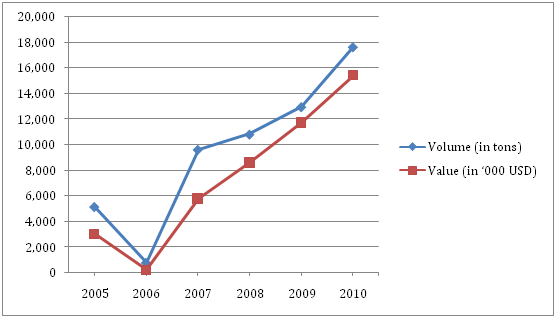
Figure 9 Ethiopian lentil Export Volume (in tons) and Value (in ‘000 USD).
Source: FAOSTAT (http://faostat3.fao.org) accessed 23 November, 2014.26
Average productivity of lentil in West Asia, North and East Africa is low due to use of predominantly local cultivars. Local cultivars have the limited yield potential and are also vulnerable to an array of stresses.8 The yield limiting factors are lack of seedling vigour, slow leaf area development, high rate of flower drop, low pod setting, poor dry matter, low harvest index, lack of lodging resistance, low or no response to inputs, and subject to various biotic and abiotic stresses.
Lentil productivity particularly in Ethiopia remains low mainly due to cultivation of low yielding, disease susceptible landraces.64,65 Low productivity per unit area and low grain quality (small seeded, undesired color, low plumpness) were typical features of Ethiopian lentils.30,66 Lentil has been under-utilized relative to other pulses. Breeders have developed very few improved varieties in Ethiopia, in addition the uptake of these has been limited and there has been little research outside breeding.
The production constraints include both biotic (insects, diseases and weeds) and abiotic (temperature, soil fertility and drought) stresses affecting the vertical or horizontal production of lentil.30,65,67 There are about ten important lentil diseases in Ethiopia, among which rust, root rots and Fusarium wilt are the major ones. Usually rust causes about 25% yield loss in the normal year while 100% crop loss seldom occurs. Pea aphids are an important insect pest threatening the crop starting from early seedling to maturity stage. Adzuki bean beetle (Bruchids) is the most serious post-harvest pest (under storage conditions).66 Coming up with resistant varieties, such as Alemaya for rust (Uromycesfabae) was a breakthrough in the breeding program and relieve to the subsistence farmer who have been suffering from losing their products of the whole field due to this particular disease.
Lentil usually matures in three and half months and harvested between mid-September and October. It should be harvested when 9% of the plants start to become yellow and the color of lower pods changed to brown or yellow-brown.37 The best time for harvest should be carefully monitored to avoid shattering of pods; Harvesting should be done only during the fresh period of the day when there is sufficient air moisture21,66). The usual period of harvesting in Ethiopia is from mid September to October.37 Most of the time harvesting is performed manually by pulling the entire plant from the soil, and then drying and threshing by beating with stick or driving oxen on the heaps.40
Lentil is an important legume crop and plays an important role in human nutrition, animal feeding and soil fertility improvement. Lentil has huge potential of reducing poverty and contributes to sustainable economic development in Ethiopia. Despite the country’s potential and sustained development efforts to get the pulse sub-sector moving, the competitiveness of lentil and hence its contribution to economic development is threatened by low productivity and inconsistent supply of products that does not met both export quality and quantity. Inadequate supply and limited popularization of improved seed sat farming household on a larger scale is the major limiting factor for adopting new varieties. Though, the proportion of farmers growing improved varieties has grown significantly, local varieties are still constituting the lion’s share in the domestic and global market. On the other hand, the ever increasing population and ever changing client demand of lentil is the good opportunity for boosting production at farm level.
Research
Of the pulse growing in Ethiopia, the only crop that got little attention in research, development and external fund attraction is lentil. The release of only nine varieties to date is a major indicator of how much the crop is ignored for improvement. Thus, the government must place lentil as a priority crop to receive funding pledges from donors. In addition, lentil should be given at least equal traction with other major pulse crops in terms of domestic research funding. Furthermore, manpower and facility investment should be increased to better enable research related to breeding, agronomy, mechanization, post-harvest handling and nutrition. In this regard, it is essential to involve the private sector in the process and development of new food products.
Seeds
The major bottlenecks related to improvement of lentil are availability, quality, sustainably emanating of seed technology and inadequate agronomic packages for production. Thus, it is essential to work with federal and regional seed enterprises, farmers’ cooperatives, unions, and seed producing farmers with involvement of private sectors in a coordinated manner to ensure adequate supply of locally certified suitable seeds. In addition, conducting on farm trials of improved lentil seeds across a nation in different agro-ecologies before broad distribution would ensure local and regional suitability. The main strategy to create enabling environment for popularization of improved varieties is to increase farmers’ awareness and access to inputs. Finally, putting in place mechanisms for lentil seed standardization, packaging, labeling and distribution that are capable of meeting farmers’ demands would help to ensure a sustainable supply of high quality improved seeds.
Fertilizers
Currently, the sole supplier of fertilizer in the country is the government run Agricultural Input Supply Enterprise. Participating private sector in fertilizer supply and distribution may have great potential to increase competition in the fertilizer market along with supply and access. It is also necessary to develop recommendations for organic and inorganic fertilizers that are most suitable for lentil production. These recommendations will depend on soil maps and controlled trials of blended fertilizers to determine the optimal balance of macro- and micro-nutrients.
On-farm production
At farm-level, the most important problem in lentil production is its poor land preparation, input costs, disease, and weed infestation. Providing of effective extension service is inevitable to break the existing resistance by awareness creation through demonstration at farmers training centers. Complementary lentil technologies including tillage frequency, seed treatment, planting techniques, genetically improve seed, disease, insects and weed management practices have to be provided to boost lentil production and to change the livelihood of Ethiopian farmers. In addition, the use of repetitive plough as an option in increasing frequency tillage costs should be further explored. In addition, mechanization research should focus on the development, testing and demonstration of intermediate technological developments to encourage changing farmers’ use of traditional farm tools. Technologies from outside the country should also be considered, though with any necessary adaptations/modifications to local conditions. The crop can be grown in various agro-ecological zones and is useful for rotations with cereals. Therefore, its role in crop production systems remains important especially in Ethiopia.
Decreasing post-harvest loss
Indeterminate growth habit of lentil makes not to mature at the same time and brought sever shattering problem before harvest. The timing of lentil harvesting is one of the mean of reducing lentil shattering lose. Harvesting lentil while it is still green is recommended as one option to reduce shattering. The promotion of multi-crop threshers would also help reduce post-harvest loss significantly, as well as increase lentil grain quality and reduce post-harvest costs. In addition, research on the development and promotion of tools (harvester) that would enable farmers to harvest lentil on time is important.
Marketing
As noted earlier, lentil has wider market opportunity domestically with increasing and ever changing client demand. There is also an increasing export demand, which can be met with research and development efforts towards increasing yield, setting up seed supply schemes and improving quality through processing industries. Even though, the price of lentil is boosted both domestically and globally still farmers are not benefited much because of involvement of brokers in the process. Strengthening and promotion of farmers’ organizations (e.g. cooperatives) and the introduction of warehouse receipt system would alleviate farmers immediate cash needs. This would enable farmers to protect from deceive middle men, which would result in increased revenues. The promotion of farmers’ level grain marketing organizations/cooperatives would also provide an additional market outlet and options to farmers, thus increasing their bargaining power and making them less exposed to the possibility of price collusion and cheating by traders. Finally, increasing farmers’ access to price information increase the transparency of the market and would enable farmers make better selling decisions and provide increased bargaining power.
Value addition
As is the case with many pulse crops in the country, the lentil value chain is at its early stages of development. Most of the value addition activities are done by the ultimate consumers themselves. The establishment of strong linkage among producers, suppliers, consumers, processors, whole sellers, and retailers is inevitable to begin value chain.
Lentil is an important legume crop and plays an important role in human, animal feeding and soil improvement. It is amongst the principal cool season food legumes and one of the less selective in terms of climate and soil features. World lentil production has increased steadily over the past decade. It is one of the heavily consumed pulse crops in Ethiopia and is a popular ingredient of every day diet in the majority of households. Lentil is grown in Ethiopia by small holder farmers without mechanization. Ethiopia shows an increasing trend in lentil productivity through enhancing net cropped and productivity per unit area. Its productivity per unit area is still very low compared to other pulse crops cultivated in the country. Ethiopia was exporter of lentil 10years ago but domestic heavy demand and high price competes well with international market. These freeze supply of products to export market aggravated with low yielding potential of existing land races and limited research attention in Ethiopia. Thereby, increasing lentil production should be considered. Agronomical and breeding research should be done and its genetic characteristics should be illuminating.
None.
The author declares no conflict of interest.

©2015 Matny. This is an open access article distributed under the terms of the, which permits unrestricted use, distribution, and build upon your work non-commercially.